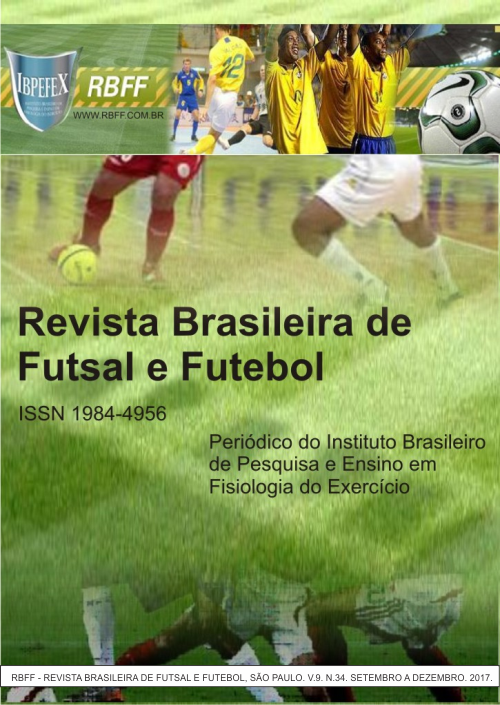Goal analysis and tendencies of a champion team during a regional futsal brazilian championship
Abstract
This Study has as a purpose to present the tendency of goals scored with the under-20 men's champion team in the maranhense futsal championship. Transversal study, with the participation of 4 teams in the maranhense under 20 men's futsal championship, thus 7 games were filmed and, in addition, the summary from the referred games were consulted. For this purpose, the following indicators were categorized: 1 - time in which the goal was scored (1th, 2th, 3th, 4th, 5th, 6th, 7th or 8th) 2 - Distance between the ball and the goal (short, medium, long and distant) and 3 - position in the futsal court (center, right-wing, left-wing). The main results showed the highest percentage of goals in the competition took place in the 7th and 8th playing time. However, the champion team was more efficient in the 1th and 2th playing time. It was also verified that the center of the court was the place with the highest prevalence of goals, both in general competition and for the champion team. For the distance in the court index, the converted goals showed a higher percentage for short distance, both for teams in general and the champion team. In conclusion, from the 3 investigated variables, two (location and distance in the court) presented the same tendency for the teams in general as well as the champion team, on the contrary, for the playing time index, a difference was observed in percentage for the accomplishment of the goals. Therefore, the coaches must have a special attention on the moments of the game, position in the court and the distance that most affect the goals in futsal, in order to set up offensive actions and especially defensive actions characterized by the founds of this study.
References
-Amaral, R.; Garganta, J. A modelação do jogo em futsal. Análise sequencial do 1x1 no processo defensivo. Revista Portuguesa de Ciências de Desporto. Vol. 5. Num. 3. 2005 p. 298-310.
-Araújo, A. L. S.; Moreira, N. L.; Moura, H. B.; Damasceno, V. O. Análise dos gols de equipes da categoria sub-15 em partidas de um torneio regional de futsal. Revista Brasileira de Futsal e Futebol. Vol. 7. Num. 23. 2015. p. 42-46. Disponível em: <http://www.rbff.com.br/index.php/rbff/article/view/317/258>
-Bezerra, R. B.; Navarro, A. C. Análise dos gols da VI Taça Brasil de Clubes 2010 na categoria sub-20 feminino. Revista Brasileira de Futsal e Futebol. Vol. 4. Núm. 11. 2012. p. 47-54. Disponível em: <http://www.rbff.com.br/index.php/rbff/article/view/124/122>
-David, G. B.; Picanço, L. M.; Reichert, F. F. Análise De Fatores Determinantes do gol no futsal feminino. Revista Brasileira de Futsal e Futebol. Vol. 6. Num. 19. 2014. p. 18-26. Disponível em: <http://www.rbff.com.br/index.php/rbff/article/view/225/208>
-Dias, R. M. R.; Santana, W. C. Tempo de incidência dos gols em equipes de diferentes níveis competitivos na copa do mundo de futsal. Lecturas: Educación Física y Desportes. Vol. 11. Num. 101. 2006.
-Fukuda, J. P. S.; Santana, W. C. Análises dos gols em jogos da Liga de Futsal 2011. Revista Brasileira de Futsal e Futebol. Vol. 4. Num. 11. 2012. p. 62-66. Disponível em: <>
-Garganta, J. A análise da performance nos jogos desportivos. Revisão acerca da análise do jogo. Revista portuguesa de ciências do desporto. Vol. 1. 2001. p. 57-64.
-Garganta, J.; Mesquita, I. (Eds.). Olhares e contextos da performance nos jogos desportivos. Porto. FCDEFUP. 2008. p. 108-121.
-Massardi, F. P.; Oliveira, M. C.; Navarro, A. C. A incidência de gols na liga de futsal feminina nos anos 2010 e 2011. Revista Brasileira de Futsal e Futebol. Vol. 3. Num. 9. 2011. p. 229-235. Disponível em: <http://www.rbff.com.br/index.php/rbff/article/view/102/96>
-Marchi, R.; e colaboradores. Incidência de gols resultantes contra-ataques de equipes de futsal. Conexões. Vol. 8. Num. 3. 2010. p. 16-22.
-Michelini, M.C.; Marques, R.F.R.; Santana, W.C.; Gutierrez, G.L. Futsal: tática defensiva contemporânea e a teoria de ensino dos jogos esportivos coletivos de Claude Bayer. Revista Conexões. Vol. 10. Num. 1. 2012. p. 20-37.
-Pessoa, V.L.; Silva, V.B.B.; Matias, C.J.A.S.; Greco, P.J. Análise dos gols da Liga Futsal 2008. Lecturas: Educación Física y Desportes. Vol. 13. Num. 129. 2009. p. 1-1.
-Santana, W. C.; e colaboradores. Análise dos gols em jogos de futsal feminino de alto rendimento. R. bras. Ci. e Mov. Vol. 21. Num. 4. 2013. p. 157-165.
-Santos, M.A.B.; Navarro, A.C. Análise dos gols da copa do mundo de futsal da Fifa 2008. Revista Brasileira de Futsal e Futebol. Vol. 2. Num. 4. 2010. p. 33-37. Disponível em: <http://www.rbff.com.br/index.php/rbff/article/view/39/39>
-Silva, R.A.M.; Calado Filho, C.M. Formación de entrenadores de futsal de máximo nivel: técnica y táctica. Espanha. Fifa. 2005.
-Siqueira, O. D.; e colaboradores. O tempo de incidência dos gols em equipes de diferentes níveis competitivos da liga nacional de futsal. Rev. Bras. Ciênc. Esporte. Vol. 36. Num. 2. 2014. p. 789-801.
Authors who publish in this journal agree to the following terms:
- Authors retain the copyright and grant the journal the right of first publication, with work simultaneously licensed under the Creative Commons Attribution License BY-NC which allows the sharing of the work with acknowledgment of the authorship of the work and initial publication in this journal.
- Authors are authorized to enter into additional contracts separately for non-exclusive distribution of the version of the work published in this journal (eg, publishing in institutional repository or book chapter), with acknowledgment of authorship and initial publication in this journal.
- Authors are allowed and encouraged to post and distribute their work online (eg, in institutional repositories or on their personal page) at any point before or during the editorial process, as this can bring about productive change as well as increase impact and impact. citation of published work (See The Effect of Free Access).





